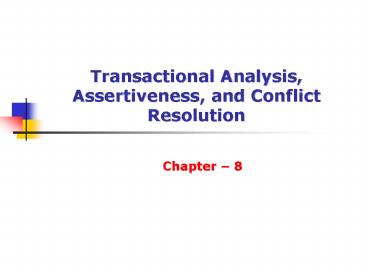Transactional Analysis, Assertiveness, and Conflict Resolution - PowerPoint PPT Presentation
1 / 16
Title:
Transactional Analysis, Assertiveness, and Conflict Resolution
Description:
Identify the differences among passive, aggressive, and assertive behavior. ... that are critical, judgmental, opinionated, demanding, disapproving, etc. ... – PowerPoint PPT presentation
Number of Views:1376
Avg rating:3.0/5.0
Title: Transactional Analysis, Assertiveness, and Conflict Resolution
1
Transactional Analysis, Assertiveness, and
Conflict Resolution
- Chapter 8
2
Learning Objectives
- Describe the three ego states of transactional
analysis. - Explain the three types of transactions.
- Identify the differences among passive,
aggressive, and assertive behavior. - List the four types of assertive behavior.
- Explain when a conflict exists.
- Explain when and how to use five conflict
management styles. - List the steps of initiating, responding to, and
mediating conflict resolutions.
3
Transactional Analysis
- Transactional analysis (TA) a method of
understanding behavior in interpersonal dynamics. - Provides helpful models for leadership styles
- Used with organizational development
- Used to help managers operate effectively within
other cultures
4
Transactional Analysis (I)
- The three ego states
- Parent
- Critical parent Behavior with evaluative
responses that are critical, judgmental,
opinionated, demanding, disapproving, etc. - Sympathetic parent behavior with reassuring
responses that are protecting, consoling,
permitting, caring, etc. - Child
- Natural child Behavior with probing responses
that show curiosity, intimacy, fantasy, etc. - Adapted child Behavior with confronting
responses that express rebelliousness, pouting,
anger, anxiety, fear, etc. - Adult
- Behavior with thinking, rational, calculating,
factual, unemotional, etc.
5
Types of Transactions
- Complementary
- Occurs when the sender of the message gets the
intended response from the receiver. - Result in more effective communication with fewer
hurt feelings and arguments. - Crossed
- Occurs when the sender of a message does not get
the expected response from the receiver. - Result in surprise, disappointment, and hurt
feelings for the sender of the message. - Ulterior or Hidden
- Occurs when the words seem to be coming from one
ego state, but in reality the words or behaviors
are coming from another.
6
Life Positions
Positive Negative
Im OK Im OK Youre not OK Youre OK Im
not OK Im not OK Youre not OK Youre OK
Attitude toward Oneself
Positive Negative
Attitude toward Others
7
Stroking
- Stroking is any behavior that implies
recognition of anothers presence. - Can be positive and negative.
- Powerful motivation technique.
- Positive strokes should always be giving.
8
Assertiveness
- Assertiveness is the process of expressing
thoughts and feelings while asking for what one
wants in an appropriate way. - When people stand up for their rights without
violating the rights of others, they are using
assertive behavior. - A way of presenting a message without falling
into stereotypical too pushy (aggressive) or
not tough enough (nonassertive-passive) traps.
9
Assertiveness Speakers Behaviors
- Passive speakers use self-limiting qualifying
expressions without stating their position/needs. - Assertive speakers state their position/needs
without violating the rights of others. - Aggressive speakers state their position/needs
while violating the rights of others using you
messages and absolutes. - Passive-aggressive speakers may switch back and
forth, may switch immediately after the
situation, or may build hostility while behaving
passively.
10
Assertiveness
- Comes through the adult ego state
- Im OK Youre OK.
- Creates a win-win situation.
- To be assertive
- Set an objective.
- Determine how to create a win-win situation.
- Develop an assertive phrase (s).
- Implement your plan persistently.
11
Conflict Management Styles
- Forcing conflict style user attempts to resolve
conflict by using aggressive behavior. - Avoiding conflict style user attempts to
passively ignore the conflict rather than resolve
it. - Accommodating conflict style user attempts to
resolve the conflict by passively giving in to
the other party. - Compromising conflict style user attempts to
resolve the conflict through assertive
give-and-take concessions. - Collaborating conflict style user assertively
attempts to jointly resolve the conflict with the
best solution agreeable to all parties.
12
Conflict Management Styles
13
Conflict Resolution
- Initiating Conflict Resolution Steps
- Plan to maintain ownership of the problem using
the XYZ model. - X (behavior), Y (consequence), Z (feeling)
- Implement your plan persistently.
- Make an agreement for change.
14
Conflict Resolution
- Responding to Conflict Resolution Steps
- Listen and paraphrase the problem using the XYZ
model. - Agree with some aspect of the complaint.
- Ask for, and/or give, alternative solutions.
- Make an agreement for change.
15
Conflict Resolution
- Mediating Conflict Resolution Steps
- Have each party state his or her complaint using
the XYZ model. - Agree on the problem (s).
- Develop alternative solutions.
- Make an agreement for change and follow up.
16
Transactional Analysis, Assertiveness, and
Conflict Resolution
- Chapter 8
- Questions, Comments ???































